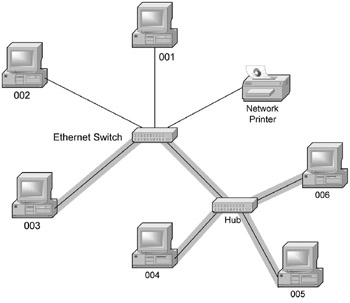Switches vs. Routers
|
|
Note well that a router is not the same thing as a switch. (I'll be talking about routers in detail in Chapter 3.) A lot of people are confused about the differences between routers and switches because in virtually all home office and small office networks, the router and switch are combined into a single box, like the famous Linksys BEFSR41. This isn't absolutely necessary, and hasn't always been the case. You can buy routers without switches and switches without routers, but the two work so well together for small networks that they usually travel together. Separate switches and routers are far more common in larger and more complex corporate networks.
Here's the way to keep them separate in your mind: Switches govern communication between different computers on a network. Routers govern communication between different networks. Routers are critical to establishing and using an Internet connection from your network, and that's a lot of what's in the next chapter.
In a sense, the switch has the more fundamental job. It creates a network from several separate computers. Without any network, a router has nothing to do.
Mixing Switches and Hubs
Using hubs and switches isn't an either-or proposition. They're often mixed in the same network simply because the hubs were there before and where the network has been extended, newer switching technology has been used instead of hubs.
Typically, a hub will connect to one of a network switch's ports as though it were a single computer, as a sort of starburst off the end of an Ethernet star. I've drawn this in Figure 2.7.The switch doesn't have the ability to create a separate single connection between a computer on one of its ports and each one of the computers attached to the hub, so it does the best it can do, which is wall off the hub and the other switched computer into the smallest possible subnetwork.
In Figure 2.7, the shaded lines indicate the path that the switch will create when it responds to computer 003's request to send a packet to computer 006. The packet will also be sent to computers 004 and 005, but once they examine the destination address they will ignore the rest of the packet, just as on a fully hubbed network. It's not as fast or efficient as a fully switched network, but it's much better than it would be with all networked devices sharing the same bandwidth equally.

Figure 2.7: A Hub as Part of a Switched Network.
|
|
EAN: 2147483647
Pages: 181